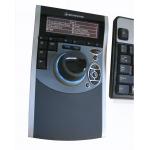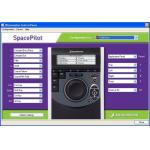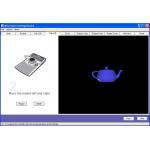Navigate in 3D: 3Dconnexion SpacePilot
The company's latest motion controller combines just the right feel with more functionality.
Latest News
December 4, 2001
By David Cohn
3Dconnexion has long promoted the concept of a two-handed approach to working in 3D environments. According to the company, using only a mouse and keyboard limits a designer’s productivity and comfort for a number of reasons. For example, a mouse can only deliver one movement at a time, with the designer constantly having to stop editing to reposition a 3D model. To back up this claim, 3Dconnexion has over the years introduced a number of 3D input devices, including the CadMan, SpaceBall, SpaceMouse, and SpaceTraveler.
The latest product from 3Dconnexion is the SpacePilot, an absolutely wonderful device that combines a 6-degree of freedom motion controller with 20 command buttons (16 of which are programmable) and an LCD screen. Like the company’s previous controllers, a large knob, which 3Dconnexion refers to as a “controller cap,” provides the 3D navigation. When used in conjunction with most 3D CAD programs, moving the cap left or right pans in those directions, pulling and pushing pans up and down, moving toward or away from you zooms in and out, and rotating or tilting the cap spins the model about its various axes.
> > Functions of buttons on the 3Dconnexion SpacePilot change automatically based on the current application and the user’s current task.
While the improved feel and response is certainly enough to recommend the SpacePilot, the addition of the LCD and programmable command buttons make this device a joy to use.
When you install the SpacePilot, its software automatically recognizes the programs already loaded on your computer and installs default configurations that predefine the functions assigned to programmable buttons.
For example, when I started SolidWorks and began to create a base sketch, the 240 x 64 LCD screen immediately showed the names of the commands assigned to the keys arrayed directly below the LCD. To begin sketching, I simply pressed button 3, which was already preassigned to activate the Sketch command. After sketching the profile, I pressed the Config button (one of two buttons located just above the controller cap) to access a second set of commands, and then pressed button 1 to immediately activate SolidWorks’ Extrude Boss/Base command. Of course, glancing down at the LCD meant that I had to take my eyes off what I was doing in SolidWorks, but after a while, I memorized these keys and no longer had to look at the LCD.
While editing a part, the other buttons were assigned to commands such as Fillet, Shell, Mirror, and Draft. When I opened an assembly in SolidWorks, the SpacePilot automatically recognized the new mode and displayed a different set of commands assigned to the keys, including Insert Components, Mate, Smart Fasteners, and Interference Detection. 
‹ ‹ Users can easily reprogram buttons or create additional button configurations using the button mapping utility.
In addition to SolidWorks, 3Dconnextion provides similar command configurations for Autodesk Inventor, Pro/Engineer Wildfire, Solid Edge, UGS NX, and a host of other CAD and DCC applications, as well as for Microsoft Office applications such as Word and Excel. For example, when used with Word, the controller cap lets you scroll through multiple pages or zoom in on your text.
You can also use the Button Mapping utility supplied with the SpacePilot to create and save your own custom configurations for other applications. When the software recognizes the current application, the button mapping utility lets you quickly assign any recognized command to the programmable buttons. If the software doesn’t recognize the command, or if it doesn’t include the desired command in its drop-down list, a macro editor lets you create and assign other commands to the buttons.
I found that the easiest way to use the SpacePilot was to position it to the left of my keyboard. With my thumb and two fingers on the controller cap, I could press the keyboard modifier keys-Esc, Shift, Ctrl, and Alt keys that duplicate similar keys on the computer’s keyboard—that sit to the left of the cap using the other two fingers of my left hand. My right hand remained on the mouse, located to the right of the keyboard. When I needed to type values, such as to specify the extrusion distance when modeling a new part in SolidWorks, I simply lifted my hand off the mouse, typed the values on the numeric keypad on the right side of my keyboard, and then put my hand back on the mouse.
Another set of buttons to the right of the controller cap provide additional control over 3D motion, such as adjusting the overall sensitivity or restricting 3D motion to a single axis at a time. Other buttons automatically reorient 3D models to the top, right, front, or left views, or immediately perform a zoom-to-fit operation in the current application.> > A Getting Started tutorial helps users learn how to manipulate the controller cap to move their models in 3D space.
Installing the SpacePilot couldn’t be easier and for those new to these types of devices, 3Dconnexion provides an excellent online tutorial with short interactive lessons to help you learn how to use a 3D motion controller. There’s also a well-written user manual and getting started guide in PDF format (in English, French, and German) as well as links to a Tips and Tricks page on the company’s website. There you’ll also find third-party software and plug-ins for other CAD programs, as well as a complete list supported programs (more than 120 at press time).
The SpacePilot works great and just feels right. And if 3Dconnexion’s claims of 10 percent to 25 percent productivity gains are accurate, the $499 price may be money well spent.
David Cohn is a computer consultant and technical writer based in Bellingham, WA. He’s a Contributing Editor to Desktop Engineering, the Editor-in-Chief of Engineering Automation Report and CADCAMNet published by Cyon Research, and the author of more than a dozen books. You can contact David through his website or click here to send him an e-mail about this article.
3Dconnexion SpacePilot
3Dconnexion
Los Gatos, CA
Price
$499
Size
5.6 x 9.3 x 2.0 inches (WxDxH)
Weight
1.75 pounds
System Requirements
Microsoft Windows 2000 or Windows XP; USB 1.1 or 2.0 interface; Intel Pentium- or AMD processor-based system; 20MB of free disk space for software installation
Subscribe to our FREE magazine, FREE email newsletters or both!
Latest News
About the Author
David Cohn is a consultant and technical writer based in Bellingham, WA, and has been benchmarking PCs since 1984. He is a Contributing Editor to Digital Engineering, the former senior content manager at 4D Technologies, and the author of more than a dozen books. Email at [email protected] or visit his website at www.dscohn.com.
Follow DE





